Friday, 15 July 2016, Fish, cruise, and art in Aix-les-Bains
Written 13 August 2016
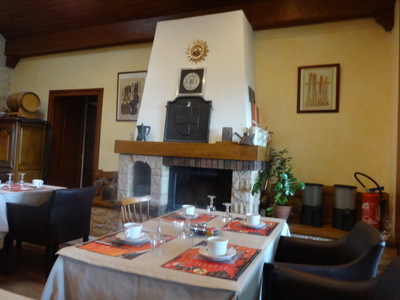

This is the neatest wall of breakfast room at the Savoy. A second wall looks over a low counter to the hotel's dining room (we never ate there), and the other two are cluttered with memorabilia and bric-a-brac, interspersed with extra cups and saucers, ready to replace those on the tables as they are used. My favorite item was a two-foot ceramic figurine of a portly chef studying the object dangling from his outstretched hand, which was not the usual hapless duck but a bricklayer's trowel.
The breakfast itself is shown at the right: basket of breads and pastries (two baguette chunks, two croissants, two whole-grain buns, and four small slices of crisp supermarket toasts), orange juice and yogurt, jams and jellies, honey and Nutella, butter in individually wrapped pats, and sugar in lumps far too large for a single cup of tea and very difficult to break in half. I succeeded, but bits of sugar went everywhere.
The paper placemats displayed a calendar of tourism-worthy events in the neighborhood. I was disappointed to learn (from a brochure in the lobby) that the cruise on the lake that I had planned, leaving from Le Bourget, would not start until the following week, and study of the placemat convinced us that the place to be was not Le Bourget but its larger neighbor across the late, Aix-les-Bains, so we decided to spend the day there.
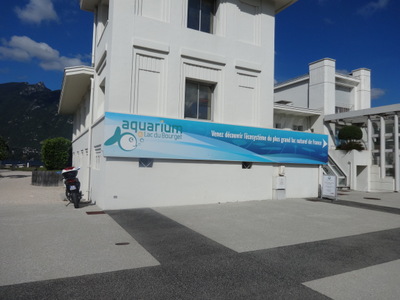
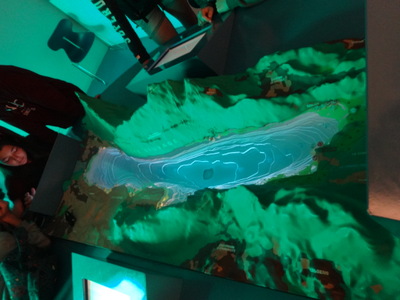 We accordingly set off in the car, driving south around the end of the lake and back about 1/3 of the way up the other side. The GPS got us to the Aquarium du Lac du Bourget, which was (as they had promised on the phone) surrounded by parking lots. Also by tourists, but they were mostly French, Swiss, and German.
We accordingly set off in the car, driving south around the end of the lake and back about 1/3 of the way up the other side. The GPS got us to the Aquarium du Lac du Bourget, which was (as they had promised on the phone) surrounded by parking lots. Also by tourists, but they were mostly French, Swiss, and German.
The aquarium turned out to be terrific. Fresh water gets short shrift at most aquaria, so I was glad to find out, finally, what grows in European lakes. They start you off in a room that tells you all about the lake itself, including this relief model showing how deep it is relative to its width and where the deepest parts are.
They also provided models of how fish can be raised in cages suspended in the water column and panels of all kinds of statistics and miscellaneous info about the lake—no it never freezes over in winter, yes it used to be polluted but has been cleaned up.
All that just keeps you busy until the movie starts. The movie was great—it traces the natural history of the lake through the seasons, focusing for structure on the life cycle of a pair of Great Crested Grebes (Grèbes huppés, Podiceps cristatus), which have a particularly spectacular mating ritual. Wonderful photography and very high information content.
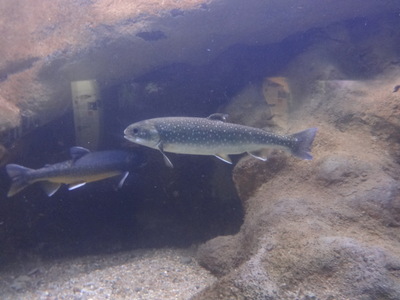
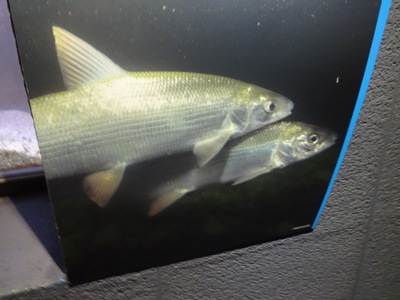 In the aquarium proper, I soon got a chance to see the species we'd been eating. At the left here is the "omble chevalier" (arctic char, Salvelinus alpinus, another salmonid). Le Bourget is near its southern limit, so it lives only in the deepest parts of the lake. It's so cold-adapted that in very far northern lakes, it's sometime the only fish. The ones in this lake are landlocked and don't migrate to the sea.
In the aquarium proper, I soon got a chance to see the species we'd been eating. At the left here is the "omble chevalier" (arctic char, Salvelinus alpinus, another salmonid). Le Bourget is near its southern limit, so it lives only in the deepest parts of the lake. It's so cold-adapted that in very far northern lakes, it's sometime the only fish. The ones in this lake are landlocked and don't migrate to the sea.
At the right is the lavaret. Doesn't look like much, but boy is it yummy.
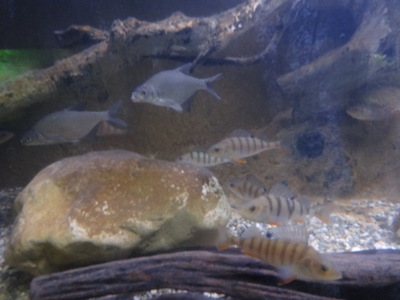
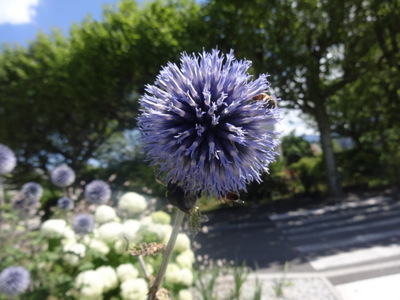 Here, at the left, are the "perchots" (the little striped fish, Perca fluviatilis), although these are rather larger than the ones I ate. The silver diamond-shaped fish in the background is a "brème commun" (Abramis brama, we never saw those on a menu); "brème" is probably cognate with "bream."
Here, at the left, are the "perchots" (the little striped fish, Perca fluviatilis), although these are rather larger than the ones I ate. The silver diamond-shaped fish in the background is a "brème commun" (Abramis brama, we never saw those on a menu); "brème" is probably cognate with "bream."
Outside the aquarium, on our way to lunch, I finally got a photo of a flower we've seen everywhere on this trip, especially along roadsides. It's a "globe thistle" (Echinops sp.); they stand three or four feet tall. They aren't really thistles, but they're in the same family (as are daisies and sunflowers). But before we got that far, we had much more of the aquarium to see.

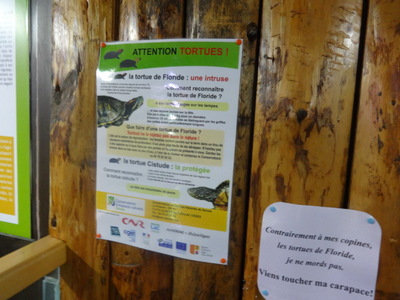 Here's the northern pike (Esox lucius, the same species we have in North America). We've eaten those in the past but never got the chance on this trip.
Here's the northern pike (Esox lucius, the same species we have in North America). We've eaten those in the past but never got the chance on this trip.
Written 15 August 2016
After the fish section, we came to a large display of stuffed birds of species that frequent the lake: several species each of ducks, grebes, seagulls, cormorants, raptors, coots (well, maybe only one species of those), and others I didn't have time to study.
Then, the turtle tank! Only two species were discussed, the native cistude d'Europe (Emys orbicularis), with a yellow-speckled head and neck, and the introduced Florida turtle" (like Florida doesn't have a couple dozen native turtles!), described as disinguishable by the red marking on its temples (is that the red-eared slider, Trachemys scripta elegans?). Managers would really like to get those Florida turtles out of the lake, as the poster makes clear. A sign on the tank of Florida turtles warns visitors to keep their fingers to themselves, because the turtles bite. The note next to the poster, though, assures visitors that cistudes don't bite and that it's safe to touch their shells.
In addition to the species I got good photos of, we saw eels (the posted description detailed the usual life cycle including migration to the sea and made no mention of Le Bourget's eels' being an exception), fario trout, sandre, sturgeon (introduced from Siberia), and many smaller species with names like rotengle, vairon, goujon, spirlin, and blageon.
The lake harbors several species of crayfish, including natives as well as species introduced from California and Russia. At least a few are harvested.
Great prominence was given to the "black bass" (Micropterus salmoides, what Americans call large-mouth bass), introduced as a sport-fishing species.
One panel charted the depths that the lake's various fish species prefered, from warmer-water species near the surface to the arctic char in the deepest areas. The lake is divided into six zones, four of which (about 3/4 of the total surface area) are reserved for the lake's 10 professional fishermen. They deploy nets at nightfall and haul them in at dawn. The other two zones (the southeastern corner) are reserved for sport fishing, which is restricted to hook and line.
Each explanatory panel listed the diet of the fish being described. Because so many of them eat insects, the museum displays a vivarium in which it raises crickets for them.
The museum even displays fishing lures and posters promoting sport fishing. I loved the place and would highly recommend it if you're ever in the area.
From the museum, we strolled (past the globe thistles) back to the car and drove the couple of kilometers to the Compagnie des Batueaux du Lac du Bourget, which claimed over the phone (their website was a mess) to have a one-hour cruise that we could fit in before lunch. Unfortunately, that information was wrong, so we signed up for an after-lunch cruise and strolled over to the Creperie du Port for lunch.
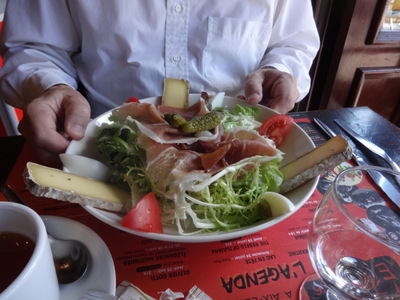
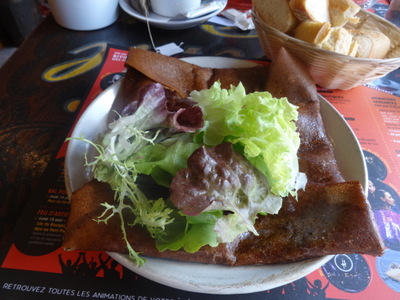 David ordered a salad as usual, this one topped with boiled egg wedges, slices of tomme, slices of raw ham, and cornichons (little sour pickles).
David ordered a salad as usual, this one topped with boiled egg wedges, slices of tomme, slices of raw ham, and cornichons (little sour pickles).
I ordered a savory crêpe (David can't eat them, because savory crêpes in France are always made with buckwheat, which David's digestive system does not regard as food). Unfortunately, it was overcooked, so the cheese had gone grainy and the egg inside was rubbery. The stewed onions and the slices of andouille (chitterling sausage) were good, though. Note that the paper placemats were identical to those at breakfast.
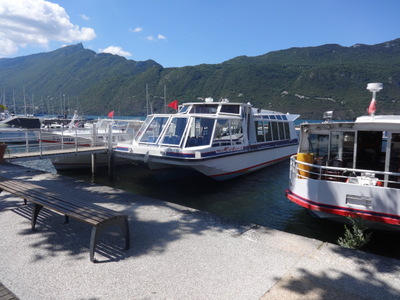
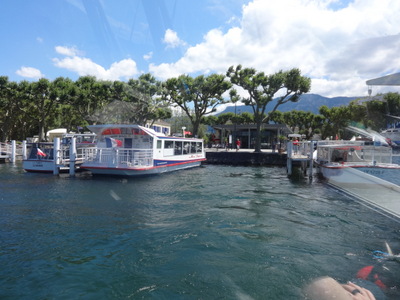 Here's our boat, the Hélios. The crew opened up the forward deck before we headed out, and surprisingly, to us, almost everyone else aboard chose to sit out there in the bright sun and howling wind. We chose the front row of the shady, sheltered, and airconditioned cabin.
Here's our boat, the Hélios. The crew opened up the forward deck before we headed out, and surprisingly, to us, almost everyone else aboard chose to sit out there in the bright sun and howling wind. We chose the front row of the shady, sheltered, and airconditioned cabin.
The right-hand photo shows the view back toward the dock as we left.
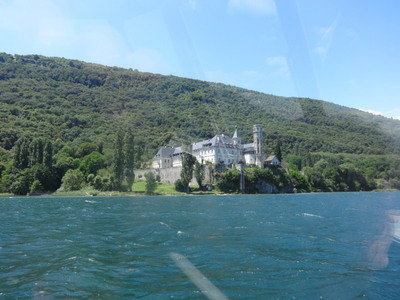
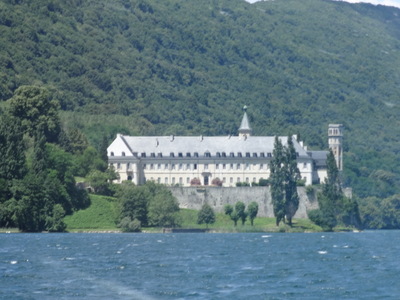 The wind was very high that day, and the lake very choppy, so the one-hour "tour" consisted pretty much entirely of running into the wind (wham, wham, wham, as we plowed through the chop) toward the Abbaye d'Hautecombe, on the opposite shore and a ways north (about 2/3 of the time), then back again downwind (about 1/3 of the time). The company runs tours of several different lengths, up to a half day, and several of them drop tourists off at the abbey, and I suspect the one-hour tours are run mainly for the convenience of those who want to come back again when no other tour happens to be passing. We dropped off and picked up a few.
The wind was very high that day, and the lake very choppy, so the one-hour "tour" consisted pretty much entirely of running into the wind (wham, wham, wham, as we plowed through the chop) toward the Abbaye d'Hautecombe, on the opposite shore and a ways north (about 2/3 of the time), then back again downwind (about 1/3 of the time). The company runs tours of several different lengths, up to a half day, and several of them drop tourists off at the abbey, and I suspect the one-hour tours are run mainly for the convenience of those who want to come back again when no other tour happens to be passing. We dropped off and picked up a few.
On the way, we saw two species of gulls, a "buse" (a common bird of prey), and swans, but not much else in the way of wildlife.
The photos show the abbey from different distances. It's about the only structure on what's called the "wild coast" of the lake. You can see a fair stretch of that coast in the background of the photo of the boat, above.

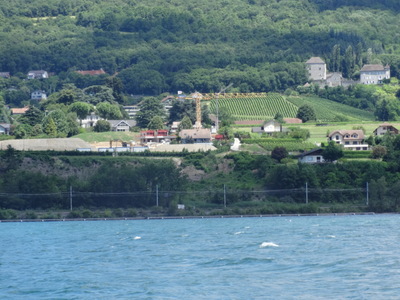 Here (left) is a photo of the "wild" (i.e., southwestern) coast. On the right is the "civilized" (eastern) coast. That's where we saw the rainstorm and rainbow from our restaurant of the night before.
Here (left) is a photo of the "wild" (i.e., southwestern) coast. On the right is the "civilized" (eastern) coast. That's where we saw the rainstorm and rainbow from our restaurant of the night before.
After our boat tour, we set off for the Musée Faure, which consists of the art collection of Dr. Jean Faure (a nationally prominent doctor of pharmacy), together with the mansion in which he lived and which now houses the museum. It's billed as housing France's second-best collection of Rodin, presumably after the Rodin Museum in Paris.
I had researched parking possibilities in the area, picked out a garage, and entered its address into the car's GPS, which proceeded to take us to the street address outside the garage's back wall! We had to bushwhack back to its entrance, on another street, without aid, as I had no idea of the entrance's address.
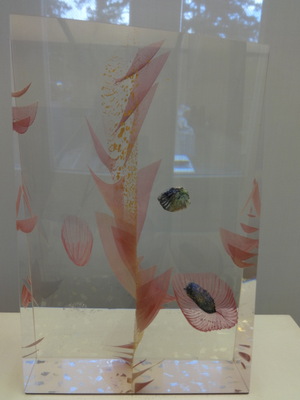
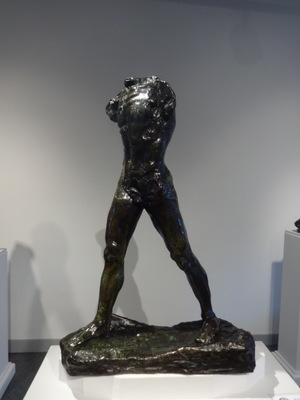 Dr. Faure's taste coincided pretty well with ours, so we enjoyed the visit a great deal. The collection includes a few modern pieces, acquired after the founder's death, like this one by Yan Zoritchak, about two feet high, called "Window on Life." It's a solid block of clear glass with interesting inclusions that do, indeed, suggest marine life. Lovely.
Dr. Faure's taste coincided pretty well with ours, so we enjoyed the visit a great deal. The collection includes a few modern pieces, acquired after the founder's death, like this one by Yan Zoritchak, about two feet high, called "Window on Life." It's a solid block of clear glass with interesting inclusions that do, indeed, suggest marine life. Lovely.
Among the Rodins, I was pleased to find this exemplar of his "Walking Man." Strangely, though, unlike the one at Smith College and the one in Paris, both of which are slightly larger than life size, this one was only about 18 inches high! The table-top model, as it were.
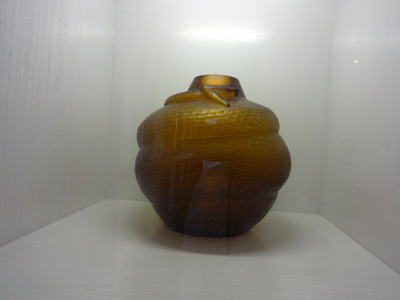
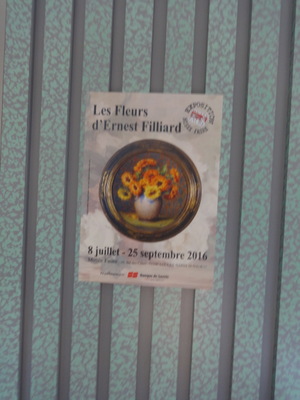 A couple of cases included art glass from Venice, but the best of the lot IMHO was this Lalique vase depicting a large coiled snake.
A couple of cases included art glass from Venice, but the best of the lot IMHO was this Lalique vase depicting a large coiled snake.
On the top floor, a couple of rooms were devoted to reconstruction of the apartment occupied by the poet Lamartine, when he lived in Aix for a while.
Perhaps best of all, though, was a temporary exhibit of flowers painted by Ernest Filliard (1868–1933). Photography was forbidden, so the best I could do was this shot of the poster. Filliard apparently sometimes painted other subjects, but the bulk of his work, and its glory, is flowers. They were stunning. I've never particularly liked zinnias, but his paintings made me see them in a whole new light. Since I can't paint them, I may have to grow some. That's not all he painted, though—he must have had extensive flower gardens. Just Google his name to see a selection of his work.
Written 16 August 2016
when we left the museum, we set the GPS to take us back to the Savoy, which, after all, it had found before, only to be directed off into a subdivision and then a cul-de-sac barred by a stout wooden fence. I wouldn't have wanted to attempt some of these trips without it (I hadn't printed out my usual Google area maps, because—duh—we had requested a car with GPS!), but that navigation system sure could be exasperating sometimes!
So we just headed back toward the lake, turned south, and continued until we struck the road that ran around the southern end of it. From there, we knew how to get to the hotel. At some point during the trip, the GPS straightened out and flew right (I could just imagine it saying, "Oh, that Savoy Hotel; not the one with the same street address in the Le Bourget-du-Lac neighborhood of Istanbul.")
Dinner was at Beaurivage, a much beloved restaurant of long standing in the neighborhood, even closer to the hotel than the previous night's. It's very proud of its designation, from some restaurant governing body, of "home made." They don't have to put "house made" next to any item on the menu, but everything is made in house. We chose the "Menu Découverte," the discovery menu.
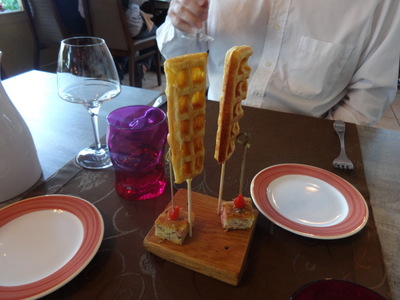
 The first amuse bouche was cheese-flavored waffles on sticks, accompanied by little squares of savory ham and olive pound cake, also on sticks. The cake skewers were speared through minute pointed red things that we couldn't identify for sure—either tiny sweet red peppers or tiny pointed cherry tomatoes.
The first amuse bouche was cheese-flavored waffles on sticks, accompanied by little squares of savory ham and olive pound cake, also on sticks. The cake skewers were speared through minute pointed red things that we couldn't identify for sure—either tiny sweet red peppers or tiny pointed cherry tomatoes.
The second amuse bouche was cubes of melon jelly in which were embedded quarter-inch cubes of watermelon. Each was topped with a thin slice of ham. I think David even ate his, melon notwithstanding.
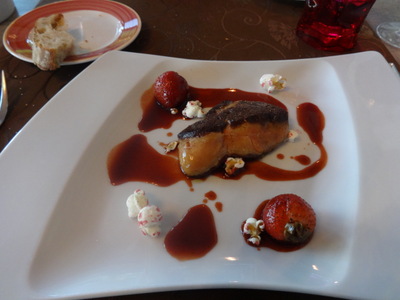
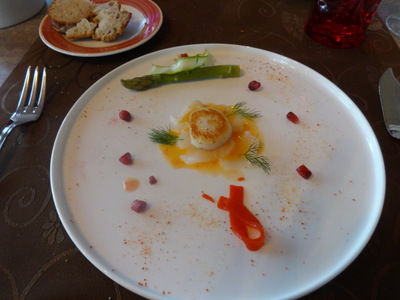 The first listed course was grilled foie gras of duck with sauce Chambérisette. The sauce involved red fruit—you can see two poached strawberries on the plate—and was garnished with a scattering of red-flecked popcorn.
The first listed course was grilled foie gras of duck with sauce Chambérisette. The sauce involved red fruit—you can see two poached strawberries on the plate—and was garnished with a scattering of red-flecked popcorn.
The second course was scallops, both thinly slice raw and lightly smoked grilled, dressed with grapefruit vinaigrette. The garnish of asparagus was also both thinly sliced raw and lightly cooked. The raw slice hides a crispy lardon. I think the ribbon at the bottom of the plate was a strip of roasted red pepper. The dark red dots around the sides are single pomegranate grains. I thought the raw scallops could have done with a little more acid.
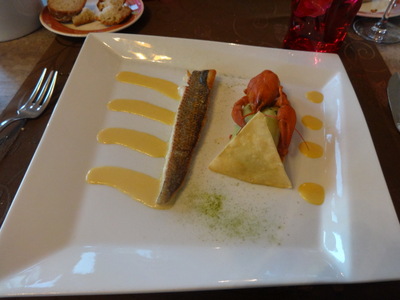
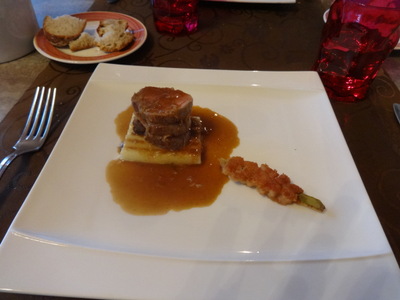 The fish course was filet of lavaret cooked on its skin until that side was crackly crisp. The plate was decorated with pools of purée preserved lemon (delicious with the fish). On the side was a small spinach and crayfish cannelloni (mostly hidden behind the triangular pasta chip) decorated with a single whole cooked crayfish.n David wasn't sure we were supposed to eat it, as we had not been supplied with fingerbowls, but I ate mine anyway.
The fish course was filet of lavaret cooked on its skin until that side was crackly crisp. The plate was decorated with pools of purée preserved lemon (delicious with the fish). On the side was a small spinach and crayfish cannelloni (mostly hidden behind the triangular pasta chip) decorated with a single whole cooked crayfish.n David wasn't sure we were supposed to eat it, as we had not been supplied with fingerbowls, but I ate mine anyway.
The meat course was a thick slice from the roasted whole filet of veal, in a ginger-flavored reduction sauce, resting on a "raft" made of long straight cooked macaroni glued together with melted Reblochon. On the side was a skewer of small pieces of veal sweetbreads sautéed until very crispy. Yummy.
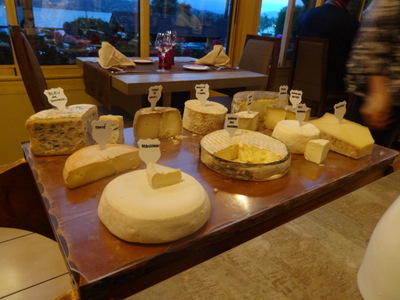
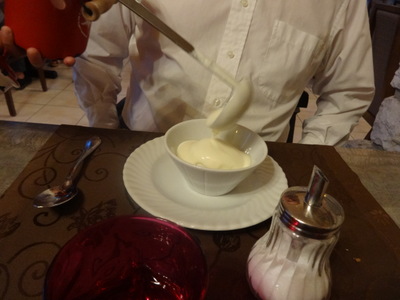 Here's the cheese trolley. From it, I chose vacherin des montagnes (the hoop front and center), tomme de brebis (second from the left in the back row), tomme de chevre (the wedge behind the hoop), and petit montagnard (the round and the wedge to the right of the hoop. All excellent.
Here's the cheese trolley. From it, I chose vacherin des montagnes (the hoop front and center), tomme de brebis (second from the left in the back row), tomme de chevre (the wedge behind the hoop), and petit montagnard (the round and the wedge to the right of the hoop. All excellent.
David, on the other hand, jumped at the chance to have another fromage blanc with cream. The photo at the left shows the waiter ladling thick cream over a rectangular "faisselle" of the stuff. Note the sugar server for ad lib application. That's how fromage blanc was served everywhere we went this year; nobody was offering salt and fresh herbs as an alternative topping.
 Dessert was detective work. The commis waiter, who usually serves the dessert, had a strong non-French accent and rattled off all the ingredients quickly, leaving us to try to remember them all and assign them to their correct little dishes.
Dessert was detective work. The commis waiter, who usually serves the dessert, had a strong non-French accent and rattled off all the ingredients quickly, leaving us to try to remember them all and assign them to their correct little dishes.
After comparing notes, tasting, and comparing notes again, we arrived at the following, clockwise from the top right: strawberry-pistachio little cake thing (no great shakes), apricots lightly stewed with rosemary in the globe with the spoon (wonderful), mint ice cream in the white leaf-shaped dish, "croustillant aux chocolat" (i.e., "crunchy chocolate thing," consisting of smooth chocolate ganache atop a layer of crispy crushed almond brittle, tall narrow glass of pineapple compote with cream and little crunchy bits on top and decorated with a diamond-shaped piece of chocolate (okay), and rounded glass of peach marmalade with custard and a crispy round chocolate cookie (excellent). We actually ate pretty much all of it.
At the end, we got into a long conversation with our hostess about where I learned French and about her trip to Florida a few years ago. During the retaurant's annual closure, she and her husband visited both Orlando and the Everglades and reports forming wonderful memories.
The commis waiter turned out to be Czech, in France on some sort of work-exchange-training thing. He was relieved to switch into English, which he speaks much better than French. He hopes eventually to live and work in the U.S.
The trip back to the hotel (without aid of GPS) was without incident.
Previous entry
List of Entries
Next entry

 We accordingly set off in the car, driving south around the end of the lake and back about 1/3 of the way up the other side. The GPS got us to the Aquarium du Lac du Bourget, which was (as they had promised on the phone) surrounded by parking lots. Also by tourists, but they were mostly French, Swiss, and German.
We accordingly set off in the car, driving south around the end of the lake and back about 1/3 of the way up the other side. The GPS got us to the Aquarium du Lac du Bourget, which was (as they had promised on the phone) surrounded by parking lots. Also by tourists, but they were mostly French, Swiss, and German.


 In the aquarium proper, I soon got a chance to see the species we'd been eating. At the left here is the "omble chevalier" (arctic char, Salvelinus alpinus, another salmonid). Le Bourget is near its southern limit, so it lives only in the deepest parts of the lake. It's so cold-adapted that in very far northern lakes, it's sometime the only fish. The ones in this lake are landlocked and don't migrate to the sea.
In the aquarium proper, I soon got a chance to see the species we'd been eating. At the left here is the "omble chevalier" (arctic char, Salvelinus alpinus, another salmonid). Le Bourget is near its southern limit, so it lives only in the deepest parts of the lake. It's so cold-adapted that in very far northern lakes, it's sometime the only fish. The ones in this lake are landlocked and don't migrate to the sea.
 Here, at the left, are the "perchots" (the little striped fish, Perca fluviatilis), although these are rather larger than the ones I ate. The silver diamond-shaped fish in the background is a "brème commun" (Abramis brama, we never saw those on a menu); "brème" is probably cognate with "bream."
Here, at the left, are the "perchots" (the little striped fish, Perca fluviatilis), although these are rather larger than the ones I ate. The silver diamond-shaped fish in the background is a "brème commun" (Abramis brama, we never saw those on a menu); "brème" is probably cognate with "bream."
 Here's the northern pike (Esox lucius, the same species we have in North America). We've eaten those in the past but never got the chance on this trip.
Here's the northern pike (Esox lucius, the same species we have in North America). We've eaten those in the past but never got the chance on this trip.
 David ordered a salad as usual, this one topped with boiled egg wedges, slices of tomme, slices of raw ham, and cornichons (little sour pickles).
David ordered a salad as usual, this one topped with boiled egg wedges, slices of tomme, slices of raw ham, and cornichons (little sour pickles).
 Here's our boat, the Hélios. The crew opened up the forward deck before we headed out, and surprisingly, to us, almost everyone else aboard chose to sit out there in the bright sun and howling wind. We chose the front row of the shady, sheltered, and airconditioned cabin.
Here's our boat, the Hélios. The crew opened up the forward deck before we headed out, and surprisingly, to us, almost everyone else aboard chose to sit out there in the bright sun and howling wind. We chose the front row of the shady, sheltered, and airconditioned cabin. 
 The wind was very high that day, and the lake very choppy, so the one-hour "tour" consisted pretty much entirely of running into the wind (wham, wham, wham, as we plowed through the chop) toward the Abbaye d'Hautecombe, on the opposite shore and a ways north (about 2/3 of the time), then back again downwind (about 1/3 of the time). The company runs tours of several different lengths, up to a half day, and several of them drop tourists off at the abbey, and I suspect the one-hour tours are run mainly for the convenience of those who want to come back again when no other tour happens to be passing. We dropped off and picked up a few.
The wind was very high that day, and the lake very choppy, so the one-hour "tour" consisted pretty much entirely of running into the wind (wham, wham, wham, as we plowed through the chop) toward the Abbaye d'Hautecombe, on the opposite shore and a ways north (about 2/3 of the time), then back again downwind (about 1/3 of the time). The company runs tours of several different lengths, up to a half day, and several of them drop tourists off at the abbey, and I suspect the one-hour tours are run mainly for the convenience of those who want to come back again when no other tour happens to be passing. We dropped off and picked up a few.
 Here (left) is a photo of the "wild" (i.e., southwestern) coast. On the right is the "civilized" (eastern) coast. That's where we saw the rainstorm and rainbow from our restaurant of the night before.
Here (left) is a photo of the "wild" (i.e., southwestern) coast. On the right is the "civilized" (eastern) coast. That's where we saw the rainstorm and rainbow from our restaurant of the night before.
 Dr. Faure's taste coincided pretty well with ours, so we enjoyed the visit a great deal. The collection includes a few modern pieces, acquired after the founder's death, like this one by Yan Zoritchak, about two feet high, called "Window on Life." It's a solid block of clear glass with interesting inclusions that do, indeed, suggest marine life. Lovely.
Dr. Faure's taste coincided pretty well with ours, so we enjoyed the visit a great deal. The collection includes a few modern pieces, acquired after the founder's death, like this one by Yan Zoritchak, about two feet high, called "Window on Life." It's a solid block of clear glass with interesting inclusions that do, indeed, suggest marine life. Lovely.
 A couple of cases included art glass from Venice, but the best of the lot IMHO was this Lalique vase depicting a large coiled snake.
A couple of cases included art glass from Venice, but the best of the lot IMHO was this Lalique vase depicting a large coiled snake.
 The first amuse bouche was cheese-flavored waffles on sticks, accompanied by little squares of savory ham and olive pound cake, also on sticks. The cake skewers were speared through minute pointed red things that we couldn't identify for sure—either tiny sweet red peppers or tiny pointed cherry tomatoes.
The first amuse bouche was cheese-flavored waffles on sticks, accompanied by little squares of savory ham and olive pound cake, also on sticks. The cake skewers were speared through minute pointed red things that we couldn't identify for sure—either tiny sweet red peppers or tiny pointed cherry tomatoes.
 The first listed course was grilled foie gras of duck with sauce Chambérisette. The sauce involved red fruit—you can see two poached strawberries on the plate—and was garnished with a scattering of red-flecked popcorn.
The first listed course was grilled foie gras of duck with sauce Chambérisette. The sauce involved red fruit—you can see two poached strawberries on the plate—and was garnished with a scattering of red-flecked popcorn.
 The fish course was filet of lavaret cooked on its skin until that side was crackly crisp. The plate was decorated with pools of purée preserved lemon (delicious with the fish). On the side was a small spinach and crayfish cannelloni (mostly hidden behind the triangular pasta chip) decorated with a single whole cooked crayfish.n David wasn't sure we were supposed to eat it, as we had not been supplied with fingerbowls, but I ate mine anyway.
The fish course was filet of lavaret cooked on its skin until that side was crackly crisp. The plate was decorated with pools of purée preserved lemon (delicious with the fish). On the side was a small spinach and crayfish cannelloni (mostly hidden behind the triangular pasta chip) decorated with a single whole cooked crayfish.n David wasn't sure we were supposed to eat it, as we had not been supplied with fingerbowls, but I ate mine anyway.
 Here's the cheese trolley. From it, I chose vacherin des montagnes (the hoop front and center), tomme de brebis (second from the left in the back row), tomme de chevre (the wedge behind the hoop), and petit montagnard (the round and the wedge to the right of the hoop. All excellent.
Here's the cheese trolley. From it, I chose vacherin des montagnes (the hoop front and center), tomme de brebis (second from the left in the back row), tomme de chevre (the wedge behind the hoop), and petit montagnard (the round and the wedge to the right of the hoop. All excellent. Dessert was detective work. The commis waiter, who usually serves the dessert, had a strong non-French accent and rattled off all the ingredients quickly, leaving us to try to remember them all and assign them to their correct little dishes.
Dessert was detective work. The commis waiter, who usually serves the dessert, had a strong non-French accent and rattled off all the ingredients quickly, leaving us to try to remember them all and assign them to their correct little dishes.